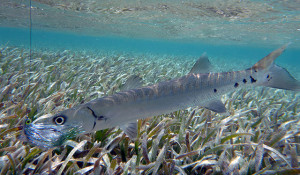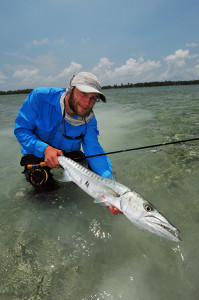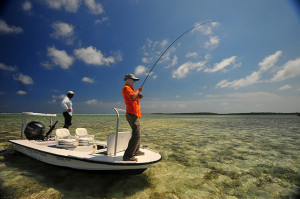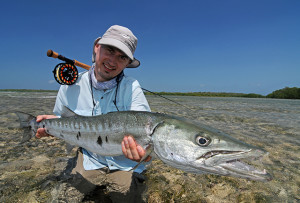Few fish spread fear and panic on the tropical flats like the barracuda, and a more cynical and calculating opponent on the fly rod is difficult to imagine.
Words By: Rasmus Ovesen
Photos By: Rasmus Ovesen, Martin Ejler Olsen
IN A LOT OF WAYS, the barracuda is the epitome of the ancient and blind evil that exists in so many different forms and shapes in nature – making us cringe with terror and fear. It is a form of evil that emanates from the abysmal depths of cold and soulless eyes, in cynical and calculating behaviour, and in an eerie ability to appear unsuspectingly. In the case of the barracuda it is an evil embodied by a perfectly camouflaged and streamlined frame, a shadow-like and ghostly presence, and grim jaws bursting with razor-sharp teeth.
The barracuda is the merciless terrorist of the tropical flats and its unpredictable demeanour, fearless behaviour and indiscriminate cold-bloodedness makes it a challenge for even the most stoic and hardcore fly fisherman. It requires nerves of steel to fish for barracudas with a fly rod. They attack at the speed of an American underwater missile and they have a creepy ability to materialise out of nowhere like ghosts and massacre your fly in explosive and sudden collisions of water, foam and flickering scales. Barracuda fly fishing, in other words, isn’t for the faint-hearted nerve wrecks but for the few staunch and dogged adventurers – those who seek the slightly self-torturous, the horrifying and the shocking.
IT IS ACTUALLY RATHER PARADOXICAL that I – an incarnated dry fly fisherman – should end up stalking the flats with trembling nerves, casting at ominous shadows. As a dry fly fisherman, I’m used to seeing fish take my fly in slow motion, and even though this is nothing short of spectacularly nerve-racking, there is a complacent obviousness to it that – in a way – provides peace of mind. It’s quite the contrary with barracuda fishing on the flats. Here, things happen so fast that your mind simply overloads. In a split second – out of nowhere – your fly disappears; an apocalyptic pull propagates through the fly line; and a big silvery shape thrusts itself metre-high out of the water. Time suddenly stands still. You see the horrifying shape of a ghostly predator hanging in the air – gills flaring, teeth exposed and eyes glistening. Then it takes the water again with its full weight making a big momentary crater in the surface film. Loose line immediately starts flying around your ears as the fish takes off at a 100mph and disappears into the fading flicker of the flat’s monochromatic water. On its way, it breaches the surface again and again frothing with rage – but you don’t even register any this. In the sudden chaos of disappearing fly line, spindrifts, and violent blank convulsions you find yourself challenged to even hang onto the flyrod and keep your knuckles from being pounded to blood by the frantic back spin of the fly reel’s spool and handle.
It isn’t until the fly reel’s tormented dirge suddenly stops, the line slackens and the fly rod’s curve straightens that the state of shock leaves your body – and by now it’s all too late. The barracuda has reached the coral reefs that shelter the big flat, the leader has been torn to pieces, and you’re left with a slightly fossilized countenance.
The whole episode slowly settles while you pick up and re-spool the lost amounts of red-hot backing. It is strewn out on the water like some sort of approximate mapping of the fish’s lightning-quick run, and you’re surprised to see how much backing was ripped off the reel in so little time. Some hundred handle-winds later, you’re now busy tying on yet another big, pulsating flash streamer in the end of a wire trace – this time with shaking and impatient hands. You’re still rather stunned and your thoughts are chaotic. There is one thing, however, that you know for sure, and you feel the assurance with every fibre in your body: you’re ready for more punishment!
TO A LARGE EXTENT, my barracuda fly fishing expeditions have evolved around the Turneffe Island Resort flats in Belize – in spite of the fact, that these flats are world-renowned for their sublime bonefish – and permit fishing. Here, you’ll find the barracudas in the wake of the massive schools of feeding bonefish that scour the back of the coral reefs or stir the mud on the flats. There are lots of barracudas in the five to 10 kilo ranges here too, and you regularly come across horrifying monsters between 15 and 20 kilos.
Bonefish are nervous by nature, but nothing startles or scares them more than patrolling barracudas. They might be fast swimmers with quick reflexes but they never underestimate the barracuda. That would be foolish – and fatal. The barracuda has a cold-blooded ability to creep up on the schools of bonefish, and if it comes close enough – or manages to single out an individual – its strike usually results in a cloudy mess of blood and whirling scales.
ESPECIALLY AT HIGH TIDE the ever-hungry barracudas move into the shallows to feed. At high tide they have a bit more water under their bellies, and the prey fish that usually find cover along the back rims of the sheltering coral reefs suddenly don’t have the same options in terms of hiding. Now, the barracudas can typically be found patrolling back and forth along the depressions behind the coral reefs – patiently waiting to come in close proximity of some unsuspecting prey item. Here, they will cynically strike anything that looks edible. The really big barracudas, however, develop a special taste for big silvery prey fish and not least bonefish. Whether it is because they taste particularly good or because they represent a suitable challenge isn’t particularly clear, but barracudas can spend hours patiently stalking bonefish in the hopes of snatching one. As a result it makes perfect sense to look for the barracudas on flats that typically boast great numbers of bonefish – and be there at high tide. Here, you’ll have optimal chances of catching a big barracuda.
BARRACUDA FLY FISHING can be approached in two tactically different ways: you can either blindfish for them or you can stalk them. The first alternative usually involves fishing relatively deep water where spotting the fish is impossible or at least extremely difficult. With that said, it should be added, that even for those with trained eyes, the barracuda is quite difficult to see – and even in knee-deep water it has an eerie ability to fully camouflage itself. Because of this, it is not only along the offshore depth curves that blind fishing for barracuda can be practised. Especially on windy days, this technique applies to the flats too. In both instances, however, the key factor is to cover a lot of water as effectively and quickly as possible. The barracuda might very well be constantly on the move, but it is more effective to search for them than waiting for them to suddenly come within casting range.
CONTRARY TO BLIND FISHING, stalking barracudas involves a lot of partially inactive waiting time, but nonetheless it might very well be the most exciting way to fly fish for barracudas. When stalking barracudas, a good pair of Polaroid sunglasses, keen eyes and good stealth skills are crucial. Wading along the coral reefs will typically result in barracuda sightings, but from the vantage point of a flats skiff stern, you have much better chances of spotting the fish.
Most often barracudas reveal themselves as discrete, elongated and blurry shadows, and once you spot one of these you’ll want to quickly place a cast 3-4 metres in front of its presumed trajectory. Then it’s all about tearing and ripping the fly back as fast as you can, because if there is one thing barracudas react violently to, it is a fleeing or panicky prey item. Consider using both hands while retrieving the fly by placing the fly rod in your armpit, and accelerate the fly as much as you can. This way, you’ll minimise the reaction time of the barracuda and hopefully trigger it into striking. If the fish is actively feeding it will react promptly and intuitively pursue the fly with flaring fins and a fixed gaze. But don’t underestimate it. The barracuda is an aggressive and fearless predator, but it is far from reckless. And since it has very acute eyesight, it will often just follow the fly inquisitively and then ignore it. The barracuda is a rather sceptical fish, and so keeping a low profile and using credible imitations or surface flies such as poppers or gurglers that provoke the fish into striking is often the key to success.
If the barracuda doesn’t launch its attack within the first 2-3 casts, you’ll want to change the fly fast and try a new one. Nothing awakens scepticism in a barracuda like seeing the same fly at close range again and again. Therefore it is a great idea to have several reserve flies mounted on wire traces or use a wire solution that enables quick fly changes.
THE GEAR, which is most commonly used for barracuda fishing, is obviously in the heavier end of the spectrum. First of all, the flies that are being used are fairly voluminous. Secondly, most tropical flats are rather unprotected and therefore, they can be quite windy. Thirdly, powerful equipment is simply needed to tame the almost unproportional powers of the barracuda.
A 9’ #10 fly rod in combination with a solid fly reel that offers good breaking power is a good outfit for barracuda. In addition, a discrete floating WF fly line with a 5-6 metre long leader and a 0.50 – 0.60mm tippet is needed. Onto the tippet, either a steelwire, wolfram or titanium tippet of 40-50lbs is mounted. Don’t fool yourself here! Ordinary fluorocarbon shock tippets or light pike wires won’t do the job for this particular fishing. A big barracuda will tear and wreck anything that isn’t 100% fine-tuned and tailor-made for the job. It is built for destruction!
THE FLIES that are typically used for barracuda are big and pulsating, up to 20-25 centimetres in length and with a bulky yet stream-lined profile. Mounted with an action disc it is possible to provide the flies with a winding and quivering movement pattern that will tease the barracuda into striking. At the same time, however, these action discs make the flies a bit inert and resistant on the retrieve, and the speed potentially lost while retrieving, sometimes speaks against using them. Some days the barracuda must have no deliberation time, while on others – especially when they have a tendency to just follow or stalk the fly – they need to be teased and lured. Here, all the tricks in the book apply including retrieve-stops, sudden accelerations and directional changes via roll casting.
Silvery flies are usually great for titillating the barracudas hunting instincts, since a lot of its favoured prey items have flickering silvery flanks and scales. Ordinary flash flies usually work fairly well, but remember: the more key stimuli you are able to code into the flies, the better they’ll fish. You might want to tie some silvery flies that not only glisten and glow but also have some volume. And tie them on ultra-sharp and heavy-wire hooks with Kevlar tying thread and ample amounts of UV or epoxy glue. Otherwise, they will be torn into smithereens when coming into contact with the barracuda’s terrifying jaws.
White flies usually work quite well too – especially when fishing relatively deep water. And when the barracuda is aggressively hunting, poppers and hot-coloured provocation flies retrieved at lightning speeds can make the barracuda lose its temper completely.
Especially popper fishing can be great fun since you’re guaranteed some spectacular strikes where the fly gets torn off the surface in furious explosions of foam and water.
WHEN THE BARRACUDA STRIKES your reaction must be prompt. Immediately set the fly with a solid strip strike, hang on for dear life, and hope for the best. Even smaller barracudas between 3–5 kilos take off irresistibly in a panicky first run. Fish between five and 10 kilos will expose most of your backing in a matter of seconds, and the big fish between 15 and 20 kilos will fire away with imminent dangers of spooled reels, over-heated brakes, straightened hooks and torn leaders. The barracuda really invests everything it has in terms of brutal ferocity and break-neck speed during the fight, and this alone makes it a desirable target for us fly fishermen. It might very well have a tarnished reputation, but it is definitely among the most exciting and nerve-racking game fish in the tropics. And it deserves our attention to a much larger extent.





